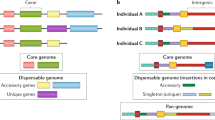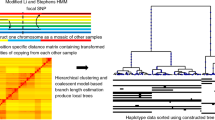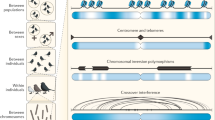Abstract
In less than half a century, molecular markers have totally changed our view of nature, and in the process they have evolved themselves. However, all of the molecular methods developed over the years to detect variation do so in one of only three conceptually different classes of marker: protein variants (allozymes), DNA sequence polymorphism and DNA repeat variation. The latest techniques promise to provide cheap, high-throughput methods for genotyping existing markers, but might other traditional approaches offer better value for some applications?
This is a preview of subscription content, access via your institution
Access options
Subscribe to this journal
Receive 12 print issues and online access
$189.00 per year
only $15.75 per issue
Buy this article
- Purchase on Springer Link
- Instant access to full article PDF
Prices may be subject to local taxes which are calculated during checkout

Similar content being viewed by others
References
Sturtevant, A. H. The linear arrangement of six sex-linked factors in Drosophila, as shown by their mode of association. J. Exp. Zool. 14, 43–59 (1913).
Hubby, J. L. & Lewontin, R. C. A molecular approach to the study of genic heterozygosity in natural populations. I. The number of alleles at different loci in Drosophila pseudoobscura. Genetics 54, 203–215 (1966).
Harris, H. Enzyme polymorphism in man. Proc. R. Soc. Lond. B 164, 298–310 (1966).
Lewontin, R. C. & Hubby, J. L. A molecular approach to the study of genic heterozygosity in natural populations. II. Amount of variation and degree of heterozygosity in natural populations of Drosophila pseudoobscura. Genetics 54, 595–609 (1966).
Johnson F., Kanapi C., Richardson R., Wheeler M. & Stone W. An analysis of polymorphisms among isozyme loci in dark and light Drosophila ananassae strains from American and Western Samoa. Proc. Natl Acad. Sci. USA 56, 119–125 (1966).
Kimura, M. Evolutionary rate at the molecular level. Nature 217, 624–626 (1968).
King, J. L. & Jukes, T. H. Non-Darwinian evolution. Science 164, 788–798 (1969).
Hillis, D. M., Moritz, C. & Mable, B. K. Molecular Systematics (Sinauer Associates, Sunderland, 1996).
Berry, A. & Kreitman, M. Molecular analysis of an allozyme cline: alcohol dehydrogenase in Drosophila melanogster on the east coast of North America. Genetics 134, 869–893 (1993).
Hudson, R. R., Bailey, K., Skarecky, D., Kwiatowski, J. & Ayala, F. J. Evidence for positive selection in the superoxide dismutase (Sod) region of Drosophila melanogaster. Genetics 136, 1329–1340 (1994).
Krieger, M. J. & Ross, K. G. Identification of a major gene regulating complex social behavior. Science 295, 328–332 (2002).
Botstein, D., White, R. L., Skolnick, M. & Davis, R. W. Construction of a genetic linkage map in man using restriction fragment length polymorphisms. Am. J. Hum. Genet. 32, 314–331 (1980).
Kerem, B. et al. Identification of the cystic fibrosis gene: genetic analysis. Science 245, 1073–1080 (1989).
Avise, J. C. Molecular Markers, Natural History and Evolution (Chapman and Hall, New York, 1994).
Jeffreys, A. J., Wilson, V. & Thein, S. L. Hypervariable 'minisatellite' regions in human DNA. Nature 314, 67–73 (1985).
Jeffreys, A. J. et al. Human minisatellites, repeat DNA instability and meiotic recombination. Electrophoresis 20, 1665–1675 (1999).
Gill, P., Jeffreys, A. J. & Werrett, D. J. Forensic application of DNA 'fingerprinting'. Nature 318, 577–579 (1985).
Armour, J. A. L., Povey, S., Jeremiah, S. & Jeffreys, A. J. Systematic cloning of human minisatellites from ordered array charomid libaries. Genomics 8, 501–512 (1990).
Saiki, R. K. et al. Enzymatic amplification of β-globin genomic sequences and restriction site analysis for diagnosis of sickle cell anemia. Science 230, 1350–1354 (1985).
Litt, M. & Luty, J. A. A hypervariable microsatellite revealed by in vitro amplification of a dinucleotide repeat within the cardiac muscle actin gene. Am. J. Hum. Genet. 44, 397–401 (1989).
Tautz, D. Hypervariability of simple sequences as a general source for polymorphic DNA markers. Nucleic Acids Res. 17, 6463–6471 (1989).
Weber, J. L. & May, P. E. Abundant class of human DNA polymorphisms which can be typed using the polymerase chain reaction. Am. J. Hum. Genet. 44, 388–396 (1989).
Goldstein, D. & Schlötterer, C. Microsatellites: Evolution and Applications (Oxford Univ. Press, Oxford, 1999).
Kong, A. et al. A high-resolution recombination map of the human genome. Nature Genet. 31, 241–247 (2002).
de Gortari, M. J. et al. A second-generation linkage map of the sheep genome. Mamm. Genome 9, 204–209 (1998).
Sakamoto, T. et al. A microsatellite linkage map of rainbow trout (Oncorhynchus mykiss) characterized by large sex-specific differences in recombination rates. Genetics 155, 1331–1345 (2000).
Queller, D. C., Strassmann, J. E. & Hughes, C. R. Microsatellites and kinship. Trends Ecol. Evol. 8, 285–288 (1993).
Schlötterer, C. Evolutionary dynamics of microsatellite DNA. Chromosoma 109, 365–371 (2000).
Ellegren, H. Microsatellite mutations in the germline: implications for evolutionary inference. Trends Genet. 16, 551–558 (2000).
Tóth, G., Gáspári, Z. & Jurka, J. Microsatellites in different eukaryotic genomes: survey and analysis. Genome Res. 10, 967–981 (2000).
Dieringer, D. & Schlötterer, C. Two distinct modes of microsatellite mutation processes: evidence from the complete genomic sequences of nine species. Genome Res. 13, 2242–2251 (2003).
Williams, J. G. K., Kubelik, A. R., Livak, K. J., Rafalski, J. A. & Tingey, S. V. DNA polymorphisms amplified by arbitrary primers are useful as genetic markers. Nucleic Acids Res. 18, 6531–6535 (1990).
Zietkiewicz, E., Rafalski, A. & Labuda, D. Genome fingerprinting by simple sequence repeat (SSR)-anchored polymerase chain reaction amplification. Genomics 20, 176–183 (1994).
Kalendar, R., Grob, T., Regina, M. T., Suoniemi, A. & Schulman, A. IRAP and REMAP: two new retrotransposon-based DNA fingerprinting techniques. Theor. Appl. Genet. 98, 704–711 (1999).
Zabeau, M. & Vos, P. Selective restriction fragment amplification: a general method for DNA fingerprinting. European Patent 0 534858 A1 (1993).
Vos, P. et al. AFLP: a new technique for DNA fingerprinting. Nucleic Acids Res. 23, 4407–4414 (1995).
Parsons, Y. M. & Shaw, K. L. Mapping unexplored genomes: a genetic linkage map of the Hawaiian cricket Laupala. Genetics 162, 1275–1282 (2002).
Castiglioni, P. et al. An AFLP-based procedure for the efficient mapping of mutations and DNA probes in barley. Genetics 149, 2039–2056 (1998).
Cervera, M. T. et al. Dense genetic linkage maps of three Populus species (Populus deltoides, P. nigra and P. trichocarpa) based on AFLP and microsatellite markers. Genetics 158, 787–809 (2001).
Menz, M. A. et al. A high-density genetic map of Sorghum bicolor (L.) Moench based on 2926 AFLP, RFLP and SSR markers. Plant Mol. Biol. 48, 483–499 (2002).
Remington, D. L., Whetten, R. W., Liu, B. H. & O'Malley, D. M. Construction of an AFLP genetic map with nearly complete genome coverage in Pinus taeda. Theor. Appl. Genet. 98, 1279–1292 (1999).
Schierwater, B. & Ender, A. Different thermostable DNA polymerases may amplify different RAPD products. Nucleic Acids Res. 21, 4647–4648 (1993).
Chen, X. & Sullivan, P. F. Single nucleotide polymorphism genotyping: biochemistry, protocol, cost and throughput. Pharmacogenomics J. 3, 77–96 (2003).
Picoult-Newberg, L. et al. Mining SNPs from EST databases. Genome Res. 9, 167–174 (1999).
Weber, J. L. & Myers, E. W. Human whole-genome shotgun sequencing. Genome Res. 7, 401–409 (1997).
Altshuler, D. et al. An SNP map of the human genome generated by reduced representation shotgun sequencing. Nature 407, 513–516 (2000).
Wakeley, J., Nielsen, R., Liu-Cordero, S. N. & Ardlie, K. The discovery of single-nucleotide polymorphisms — and inferences about human demographic history. Am. J. Hum. Genet. 69, 1332–1347 (2001).
Nielsen, R. & Signorovitch, J. Correcting for ascertainment biases when analyzing SNP data: applications to the estimation of linkage disequilibrium. Theor. Popul. Biol. 63, 245–255 (2003).
Kuhner, M. K., Beerli, P., Yamato, J. & Felsenstein, J. Usefulness of single nucleotide polymorphism data for estimating population parameters. Genetics 156, 439–447 (2000).
Brumfield, R. T., Beerli, P., Nickerson, D. A. & Edwards, S. V. The utility of single nucleotide polymorphism in inferences of population history. Trends Ecol. Evol. 18, 249–256 (2003).
Meyer, S., Weiss, G. & von Haeseler, A. Pattern of nucleotide substitution and rate heterogeneity in the hypervariable regions I and II of human mtDNA. Genetics 152, 1103–1110 (1999).
Schlötterer, C. & Harr, B. Single nucleotide polymorphisms derived from ancestral populations show no evidence for biased diversity estimates in Drosophila melanogaster. Mol. Ecol. 11, 947–950 (2002).
McVean, G., Awadalla, P. & Fearnhead, P. A coalescent-based method for detecting and estimating recombination from gene sequences. Genetics 160, 1231–1241 (2002).
Kuhner, M. K., Yamato, J. & Felsenstein, J. Maximum likelihood estimation of recombination rates from population data. Genetics 156, 1393–1401 (2000).
Beerli, P. & Felsenstein, J. Maximum likelihood estimation of a migration matrix and effective population sizes in n subpopulations by using a coalescent approach. Proc. Natl Acad. Sci. USA 98, 4563–4568 (2001).
Kreitman, M. Nucleotide polymorphism at the alcohol dehydrogenase locus of Drosophila melanogaster. Nature 304, 412–417 (1983).
Kreitman, M. Methods to detect selection in populations with applications to the human. Annu. Rev. Genom. Hum. Genet. 1, 539–559 (2000).
Chikhi, L., Bruford, M. W. & Beaumont, M. A. Estimation of admixture proportions: a likelihood-based approach using Markov chain Monte Carlo. Genetics 158, 1347–1362 (2001).
Reich, D. E., Feldman, M. W. & Goldstein, D. B. Statistical properties of two tests that use multilocus data sets to detect population expansions. Mol. Biol. Evol. 16, 453–466 (1999).
Wilson, I. J. & Balding, D. J. Genealogical inference from microsatellite data. Genetics 150, 499–510 (1998).
Beaumont, M. A. Detecting population expansion and decline using microsatellites. Genetics 153, 2013–2029 (1999).
Kuhner, M. K., Yamato, J. & Felsenstein, J. Estimating effective population size and mutation rate from sequence data using Metropolis-Hastings sampling. Genetics 140, 1421–1430 (1995).
Harpending, H. C. et al. Genetic traces of ancient demography. Proc. Natl Acad. Sci. USA 95, 1961–1967 (1998).
Wall, J. D., Andolfatto, P. & Przeworski, M. Testing models of selection and demography in Drosophila simulans. Genetics 162, 203–216 (2002).
Glaubitz, J. C., Rhodes, O. E. & Dewoody, J. A. Prospects for inferring pairwise relationships with single nucleotide polymorphisms. Mol. Ecol. 12, 1039–1047 (2003).
Terwilliger, J. D., Haghighi, F., Hiekkalinna, T. S. & Goring, H. H. A bias-ed assessment of the use of SNPs in human complex traits. Curr. Opin. Genet. Dev. 12, 726–734 (2002).
Ohashi, J. & Tokunaga, K. Power of genome-wide linkage disequilibrium testing by using microsatellite markers. J. Hum. Genet. 48, 487–491 (2003).
Schlötterer, C. Hitchhiking mapping — functional genomics from the population genetics perspective. Trends Genet. 19, 32–38 (2003).
Kayser, M., Brauer, S. & Stoneking, M. A genome scan to detect candidate regions influenced by local natural selection in human populations. Mol. Biol. Evol. 20, 893–900 (2003).
Kohn, M. H., Pelz, H. J. & Wayne, R. K. Natural selection mapping of the warfarin-resistance gene. Proc. Natl Acad. Sci. USA 97, 7911–7915 (2000).
Payseur, B. A., Cutter, A. D. & Nachman, M. W. Searching for evidence of positive selection in the human genome using patterns of microsatellite variability. Mol. Biol. Evol. 19, 1143–1153 (2002).
Harr, B., Kauer, M. & Schlötterer, C. Hitchhiking mapping — a population based fine mapping strategy for adaptive mutations in D. melanogaster. Proc. Natl Acad. Sci. USA 99, 12949–12954 (2002).
Vigouroux, Y. et al. Identifying genes of agronomic importance in maize by screening microsatellites for evidence of selection during domestication. Proc. Natl Acad. Sci. USA 99, 9650–9655 (2002).
Akey, J. M., Zhang, G., Zhang, K., Jin, L. & Shriver, M. D. Interrogating a high-density SNP map for signatures of natural selection. Genome Res. 12, 1805–1814 (2002).
Sabeti, P. C. et al. Detecting recent positive selection in the human genome from haplotype structure. Nature 419, 832–837 (2002).
Gill, P. An assessment of the utility of single nucleotide polymorphism (SNPs) for forensic purposes. Int. J. Legal Med. 114, 204–210 (2001).
Kruglyak, L. The use of a genetic map of biallelic markers in linkage studies. Nature Genet. 17, 21–24 (1997).
Leal, S. M. Genetic maps of microsatellite and single-nucleotide polymorphism markers: are the distances accurate? Genet. Epidemiol. 24, 243–252 (2003).
Schlötterer, C. in Molecular Genetic Analysis of Populations: A Practical Approach 2nd edn (ed. Hoelzel, A. R.) 237–261 (Oxford Univ. Press, Oxford, 1998).
Stephens, M. & Donnelly, P. A comparison of Bayesian methods for haplotype reconstruction from population genotype data. Am. J. Hum. Genet. 73, 1162–1170 (2003).
Fischer, S. G., & Lerman, L. S. DNA fragments differing by single base-pair substitutions are seperated in denaturing gradient gels: correspondence with melting theory. Proc. Natl Acad. Sci. USA 80, 1579–1583 (1983).
Myers, R. M., Lumelsky, N., Lerman, L. S. & Maniatis, T. Detection of single base substitutions in total genomic DNA. Nature 313, 495–497 (1985).
Rosenbaum, V. & Riesner, D. Temperature gradient gel electrophoresis: thermodynamic analysis of nucleic acids and proteins in purified formand in cellular extracts. Biophys. Chem. 26, 235–246 (1987).
Hayashi, K. PCR-SSCP: a simple and sensitive method for detection of mutations in the genomic DNA. PCR Methods Appl. 1, 34–38 (1991).
Orita, M., Iwahana, H., Kanazawa, H., Hayashi, K. & Sekiya, T. Detection of polymorhisms of human DNA by gel electrophoresis as single-strand conformation polymorphisms. Proc. Natl Acad. Sci. USA 86, 2766–2770 (1989).
White, M. B., Carvalho, M., Derse, D., O'Brien, S. J. & Dean, M. Detecting single base substitutions as heteroduplex polymorphisms. Genomics 12, 301–306 (1992).
Acknowledgements
I am very thankful to R. Achmann, B. Harr, M.-T. Hauser, R. Nielsen, T. Leeb, C. Vogl and two anonymous reviewers for helpful discussion/comments on earlier versions of the manuscript. The laboratory of C.S. is supported by grants from the Fonds zur Förderung der Wissenschaftlichen Forschung and the European Union.
Author information
Authors and Affiliations
Ethics declarations
Competing interests
The author declares no competing financial interests.
Related links
Glossary
- AMPLIFIED FRAGMENT LENGTH POLYMORPHISM
-
(AFLP). This marker system uses DNA fragments that are ligated to complementary adaptor oligonucleotides and subsequent rounds of PCR amplification using primers that are complementary to the adaptor sequences. The multiple rounds of amplification reduce the complexity of the PCR product population so that the amplified fragments can be easily resolved by gel electrophoresis.
- ADMIXTURE
-
Gene flow between differentiated populations.
- ASCERTAINMENT BIAS
-
Systematic bias introduced by the criteria used to select individuals and/or loci in which genetic variation is assayed; a pronounced problem for single nucleotide polymorphism (SNP) and restriction fragment length polymorphism (RFLP) analyses.
- ASSOCIATION STUDY
-
A study that aims to identify the joint occurrence of two genetically encoded characteristics in a population. Often, an association between a genetic marker and a phenotype (disease) is assessed.
- EUCHROMATIN
-
Part of an interphase chromosome that stains diffusely; less condensed than the heterochromatin.
- F ST
-
Wright's among-population fixation index. A measure of the extent of population subdivision.
- GENE CONVERSION
-
Non-reciprocal exchange of genetic material among chromosomes.
- INTER-RETROTRANSPOSON AMPLIFIED POLYMORPHISM
-
(IRAP). DNA fragments found between adjacent, oppositely oriented retrotransposons, amplified through PCR, separated by gel electrophoresis and scored for the presence or absence of fragments.
- INTER-SIMPLE-SEQUENCE-REPEAT
-
(ISSR). DNA fragments found between adjacent, oppositely oriented microsatellites, amplified through PCR, separated by gel electrophoresis and scored for the presence or absence of fragments.
- LINKAGE DISEQUILIBRIUM
-
Haplotype frequencies in a population that differ from expectations based on a random combination of alleles at each locus.
- PHYLOGENETIC RECONSTRUCTION
-
Attempt to reconstruct the ancestral relationship among species or populations.
- RANDOMLY AMPLIFIED POLYMORPHIC DNA
-
(RAPD). A marker system that relies on the use of short PCR primers.
- RESTRICTION FRAGMENT LENGTH POLYMORPHISM
-
(RFLP). A fragment length variant that is generated through the presence/absence of a restriction enzyme recognition site. Restriction sites could be gained/lost by base substitutions, insertions or deletions.
- STUTTER BANDS
-
Artifacts that occur by DNA-replication slippage during the PCR amplification of microsatellites. Most stutter bands are shorter than the actual microsatellite allele.
Rights and permissions
About this article
Cite this article
Schlötterer, C. The evolution of molecular markers — just a matter of fashion?. Nat Rev Genet 5, 63–69 (2004). https://doi.org/10.1038/nrg1249
Issue Date:
DOI: https://doi.org/10.1038/nrg1249
This article is cited by
-
Multispecies genetic approach reveals divergent connectivity patterns in marine fish from Western Atlantic
Marine Biodiversity (2024)
-
Genetic diversity analysis in chrysanthemum (Dendranthema grandiflora Tzvelev) using SSR markers: corroborating mutant behaviour of newly evolved genotypes
Genetic Resources and Crop Evolution (2023)
-
Genetic variation in natural and nursery populations of Styrax magnus (Styracaceae) for the restoration of humid mountain forests in southern Mexico
New Forests (2022)
-
The Clam Cyclina sinensis (Gmelin) Phylogeography Study with 28S rRNA Gene and Potential of Nuclear rRNA Genes in Genetic Assessments of Molluscs
Journal of Ocean University of China (2022)
-
Development and validation of genome-wide InDel markers with high levels of polymorphism in bitter gourd (Momordica charantia)
BMC Genomics (2021)



